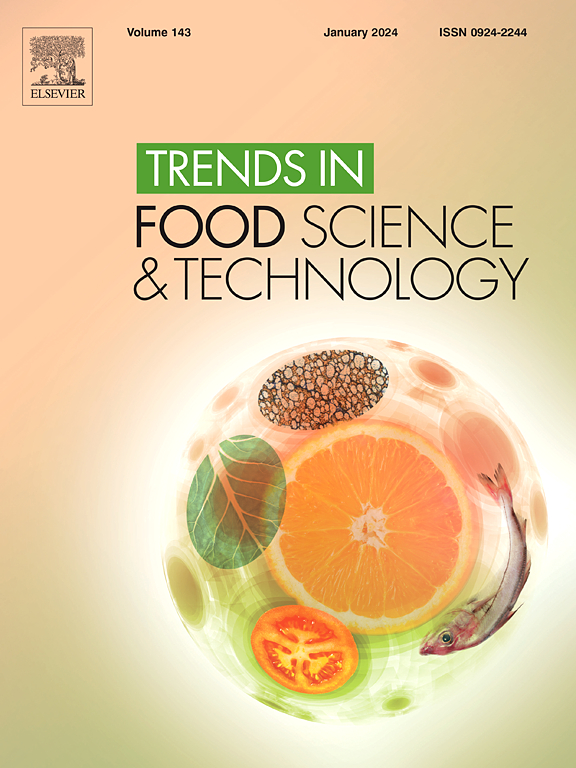水果供应链中的现代智能传感技术:贡献、挑战和未来展望
IF 15.1
1区 农林科学
Q1 FOOD SCIENCE & TECHNOLOGY
引用次数: 0
摘要
传统上,水果质量检验是一个劳动密集型和耗时的过程。然而,现代智能传感技术的最新进展为应对这些挑战提供了创新的解决方案。本文综述了现代智能传感技术在水果供应链中应用的最新研究进展。本文主要介绍了柔性传感器、光纤传感器、生物传感器和电化学传感器等先进传感技术在水果供应链各个环节的最新应用。它强调了成熟度预测、农药残留检测、储运过程中的新鲜度监测以及机械损伤识别等方面的重大进展。此外,本文还探讨了这些传感技术与数字孪生技术、人工智能和物联网的整合,旨在应对未来的挑战,提高水果供应链的整体效率。主要发现和结论现代智能传感技术已经在广泛的应用中显示出相当大的有效性。这些包括预测水果成熟度,设计收获驱动器,检测农药残留,实现智能包装,在运输和储存过程中保持新鲜度,以及识别机械损伤。传感技术与机器学习的结合提高了传感器的灵敏度,提高了数据采集能力。它们的实施有助于优化资源配置,更好地协调供应链各环节,提高经济效率。这篇综述强调了现代智能传感技术在革新工业化农业实践和促进更可持续和数据驱动的水果供应链管理方法方面的变革潜力。本文章由计算机程序翻译,如有差异,请以英文原文为准。
Modern smart sensing technologies in the fruit supply chain: contributions, challenges, and future prospects
Background
Fruit quality inspection is traditionally a labor-intensive and time-consuming process. However, recent advancements in modern smart sensing technologies provide innovative solutions to address these challenges. This review summarizes the latest research developments in the application of modern smart sensing technologies throughput the fruit supply chain.
Scope and approach
This review focuses on the recent applications of advanced sensing technologies, such as flexible sensors, optical fiber sensors, biosensors, and electrochemical sensors, across different stages of the fruit supply chain. It highlights significant progresses areas such as ripeness prediction, pesticide residue detection, freshness monitoring during storage and transportation, and identification of mechanical damage. Additionally, the review explores the integration of these sensing technologies with digital twin technology, artificial intelligence, and the Internet of Things, aiming to address future challenges and enhance the overall efficiency of the fruit supply chain.
Key findings and conclusions
Modern smart sensing technologies have demonstrated considerable effectiveness in a wide range of applications. These include predicting fruit ripeness, designing harvesting actuators, detecting pesticide residues, enabling intelligent packaging, preserving freshness during transportation and storage, and identifying mechanical damage. The integration of sensing technologies with machine learning enhances sensor sensitivity and improves data acquisition capabilities. Their implementation contributes to optimized resource allocation, better coordination across supply chain segments, and increased economic efficiency. This review highlights the transformative potential of modern smart sensing technologies in revolutionizing industrial agricultural practices and promoting a more sustainable and data-driven approach to fruit supply chain management.
求助全文
通过发布文献求助,成功后即可免费获取论文全文。
去求助
来源期刊

Trends in Food Science & Technology
工程技术-食品科技
CiteScore
32.50
自引率
2.60%
发文量
322
审稿时长
37 days
期刊介绍:
Trends in Food Science & Technology is a prestigious international journal that specializes in peer-reviewed articles covering the latest advancements in technology, food science, and human nutrition. It serves as a bridge between specialized primary journals and general trade magazines, providing readable and scientifically rigorous reviews and commentaries on current research developments and their potential applications in the food industry.
Unlike traditional journals, Trends in Food Science & Technology does not publish original research papers. Instead, it focuses on critical and comprehensive reviews to offer valuable insights for professionals in the field. By bringing together cutting-edge research and industry applications, this journal plays a vital role in disseminating knowledge and facilitating advancements in the food science and technology sector.
 求助内容:
求助内容: 应助结果提醒方式:
应助结果提醒方式:


